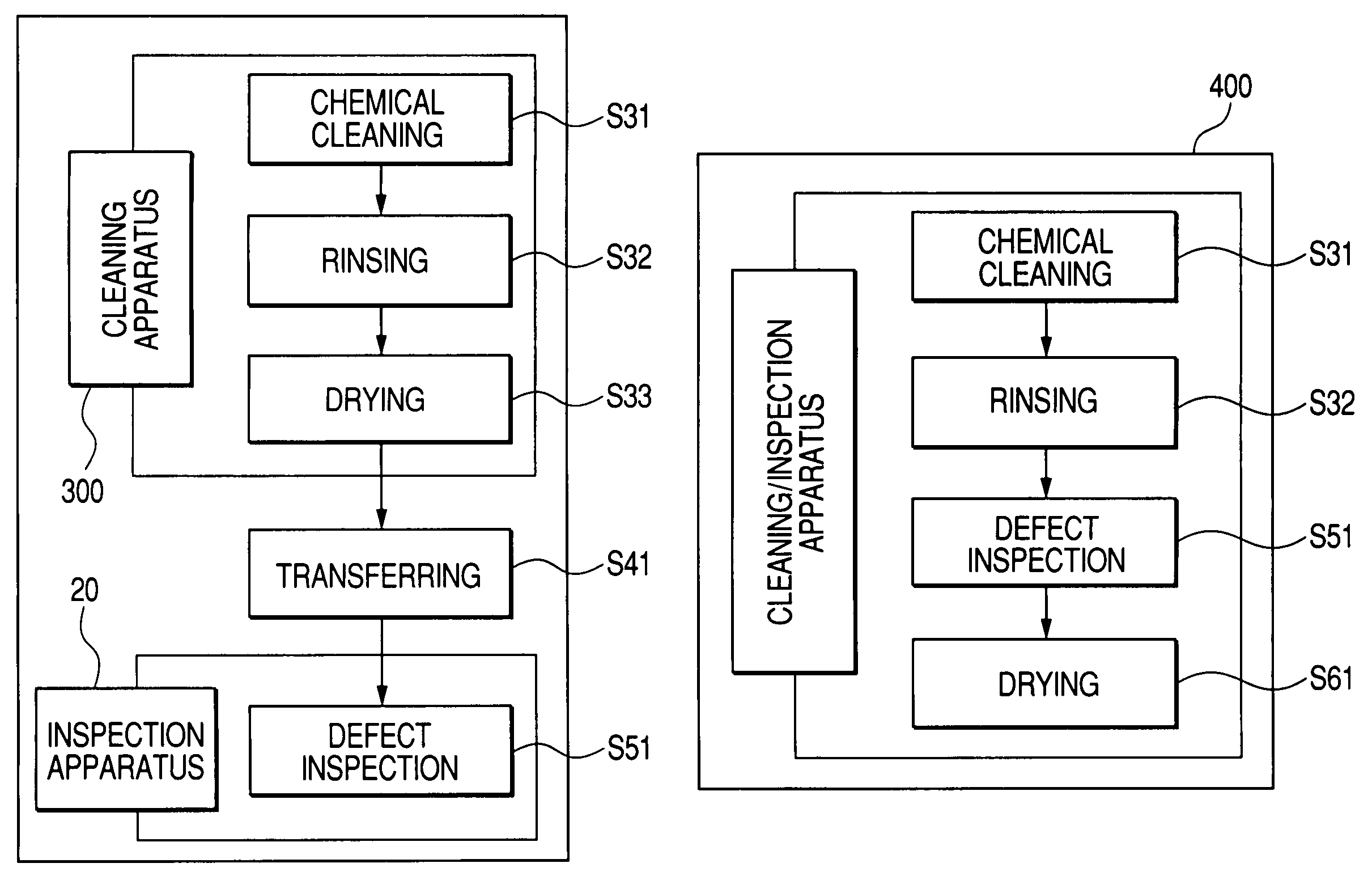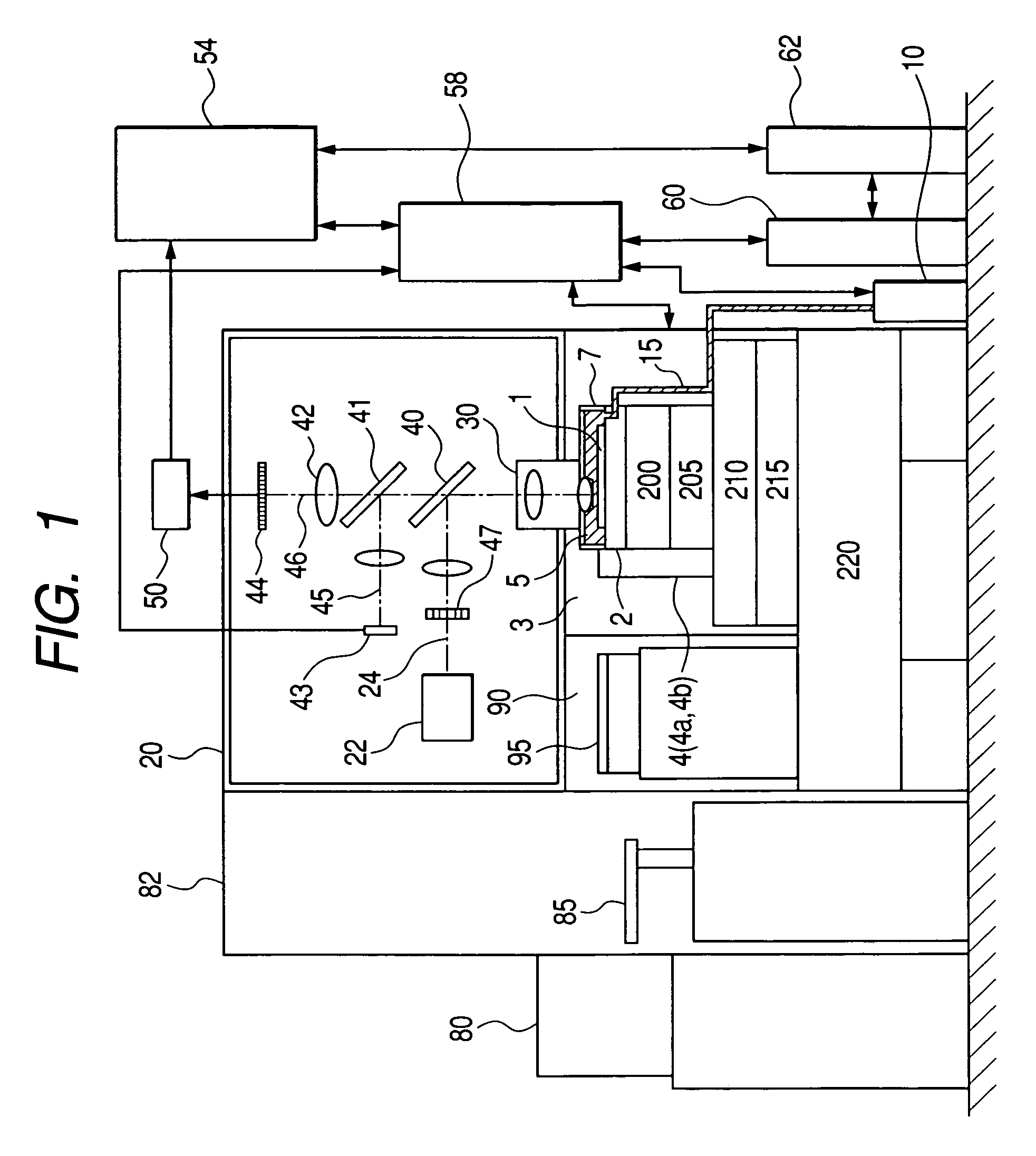Method and apparatus for inspecting defects and a system for inspecting defects
a technology of defect inspection and defect, applied in semiconductor/solid-state device testing/measurement, instruments, material analysis, etc., can solve the problems of increasing apparatus costs, affecting the accuracy of inspection, and reducing the effectiveness of inspection, so as to improve the effective na and improve the resolution
- Summary
- Abstract
- Description
- Claims
- Application Information
AI Technical Summary
Benefits of technology
Problems solved by technology
Method used
Image
Examples
first embodiment
[0040]A first embodiment in which the total liquid immersion method that forms part of the liquid immersion technology according to the present invention is applied to an optical-type visual inspection apparatus for semiconductor wafers will be described using FIG. 1. Wafers to be inspected are stored in a cassette 80, and each of the wafers is transferred to an inspection preparation chamber 90 by a wafer transfer robot 85 and then mounted on a wafer notch (or orientation flat) detector unit 95. The wafer is prealigned in a desired direction by the wafer notch detector unit 95. Next, the wafer is transferred to an inspection station 3. In the inspection station 3, wafer 1 is fixed by a chuck 2, and the wafer 1 is totally immersed in a liquid 5 with which a liquid tank (a liquid vessel) 7 is filled. The liquid tank 7 is connected to a liquid supply / discharge unit 10 by a pipe 15, and the liquid tank 7 supplies the liquid 5 after loading of the wafer 1, and discharges the liquid 5 be...
second embodiment
[0077]A second embodiment in which the local liquid immersion method that forms part of the liquid immersion technology according to the present invention is applied to an optical-type visual inspection apparatus for semiconductor wafers will be described using FIG. 8. Unlike the total liquid immersion method shown in FIG. 1, the local liquid immersion method is used to immerse only the interspace between the objective lens 30 and the wafer 1, in a liquid. A basic configuration of the second embodiment is much the same as that of the first embodiment, except for the inside of the inspection station 3. For example, for a linear type of image sensor 44, images are acquired while the wafer 1 is being moved at a fixed speed. A liquid 5 is fed from a liquid supply / discharge unit 10 into a liquid supply controller 181 at a specific pressure. The liquid, after having its flow rate, temperature, and other factors controlled by the liquid supply controller 181, is supplied to the surface of ...
third embodiment
[0094]Next, an example of configuration of a visual inspection optical system which uses liquid immersion, and a method for improving this optical system in resolution will be described below using FIG. 16.
[0095](1) An interspace between an objective lens 30 and a wafer 1 is immersed in a liquid 5 and thus, resolution is improved.
[0096](2) In an incident illumination / bright-field detection scheme, when Koheler illumination is applied, an image of a light source 22 is formed on an aperture stop (an aperture diaphragm) 425. This image is further formed on a pupil of the objective lens 30. If the aperture stop 425 has a ring-form (zonal) aperture portion, light that illuminates one point on the wafer 1 becomes oblique illumination light not having a vertical illumination light component. Use of the illumination light improves high-frequency MTF (Modulation Transfer Function) of a spatial frequency.
[0097](3) Furthermore, when a polarizing type of beam splitter 40a is used, the light ref...
PUM
| Property | Measurement | Unit |
|---|---|---|
| wavelength | aaaaa | aaaaa |
| wavelength | aaaaa | aaaaa |
| refractive index | aaaaa | aaaaa |
Abstract
Description
Claims
Application Information
 Login to View More
Login to View More - R&D
- Intellectual Property
- Life Sciences
- Materials
- Tech Scout
- Unparalleled Data Quality
- Higher Quality Content
- 60% Fewer Hallucinations
Browse by: Latest US Patents, China's latest patents, Technical Efficacy Thesaurus, Application Domain, Technology Topic, Popular Technical Reports.
© 2025 PatSnap. All rights reserved.Legal|Privacy policy|Modern Slavery Act Transparency Statement|Sitemap|About US| Contact US: help@patsnap.com



